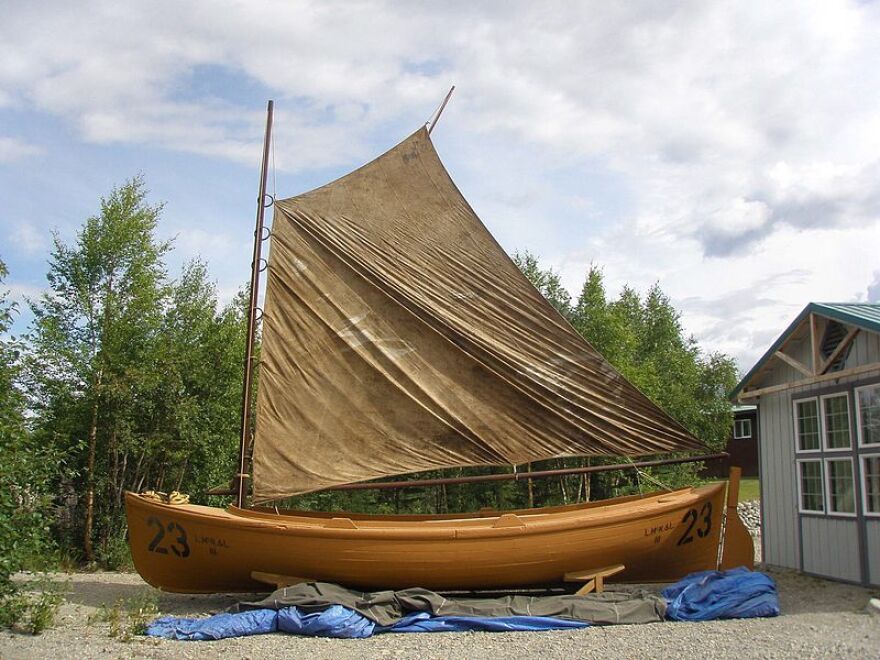There’s no doubt commercial fishing is hard work. But what was it like a century ago?
The double-ender sailboat is a relic of the non-motorized Bristol Bay fishery that disappeared in the early 1950s. One of these boats is on display at Lake Clark National Park in Port Alsworth -- a 30-footer built in 1914 in a West Coast shipyard, named Libby's No. 23.
Libby’s No. 23 was one of the thousands of wooden sailboats manned by two-man crews back when the Bristol Bay fleet was totally at the mercy of the wind and the tides.
“Not only did you have to be a good fisherman in this era, you had to be a darn good sailor,” said John Branson, the historian for Lake Clark National Park in Port Alsworth.
You had to be a skilled sailor back then, he says, because mistakes could cost you dearly.
“When you were trying to deliver fish to the scow, if you missed it, you might have to wait 12 hours ‘til the tide changed to come back around.”
The result could be a boat full of spoiled fish – or much worse.
“You know, there’s a section of the Kvichak Bay called Dead Man Sands,” says Branson. “If they went dry in that shallow bay and then the riptide came back in, if they were sideways, broadside to the oncoming tide, with a big wind, they could swamp. And many did.”
This, says Branson, is the reason for the butterscotch brownish-orange paint job on this boat.
“Every cannery had their own color scheme, so this is Libby’s orange,” says Branson, “because they didn’t have radios to communicate. So the superintendent could look out with binoculars, so he could identify his boats out there fishing by visual, by the color.
In this way, the boss would know if all his boats were accounted for, or if he had to send out a monkey-boat to tow some crew to safety.
Most Bristol Bay fishermen during this era were from Italy and Northern Europe. According to the book ‘Sailing for Salmon,’ there could be fierce rivalry between the nationalities, as they tried to out-fish each other. And judging by the two types of stoves on display in the Libby’s No. 23, it seems they couldn’t agree on the best way to cook, either.
“The Italians favored the Santa Maria stove, it was a coal-burner, where they would make their cioppino, spaghettis and stuff. And the Swedes, Norwegian people, everyone else, liked those Primus Optimus Swede stoves.”
A mealtime staple for many were hard-tack biscuits, the nigh-unbreakable forerunner of pilot bread.
“The Italian word for it is gallette, and if you think you could just chew that like you do a pilot bread, forget it, you’ll have to go see a dentist! That’ll break your teeth, literally. That is cast-iron stuff.”
Of course, with just a tent for shelter onboard the double-enders, the food had to be tough, as did the fishermen and their gear. Long before Grundens and neoprene were invented, fishermen would wear oil skins, an old-fashioned type of rain jacket.
“They would have to put Vaseline around their wrists because it was rigid and would chafe.”
Also on display are an impressive pair of leather “fin” boots, worn by the late Governor Jay Hammond and donated by his widow Bella.

Among the hardy men who manned the Libby No. 23 was a schoolteacher named John Coray.
“He’s the man that brought the boat up from Graveyard cannery, Libby’s Koggiung.”
Using a small gas engine in 1953, Coray brought the Libby’s #23 up the Kvichak to where he and his wife were teaching school in Pedro Bay. By the next year, they’d hauled the double-ender on a trailer from Iliamna over the Newhalen portage road to the upper Newhalen River. That’s how it got, eventually, to Lake Clark, where it was used by several families for recreation, subsistence and hauling cargo. It was donated to the National Park in 1997 by Al Woodward.
By Branson’s estimate, Libby’s No. 23 is one of only a dozen or so museum-quality double-enders left in existence. In 2013, he successfully got it listed on the National Register of Historic Places.
It’s the only such listing from the world’s last great wild salmon fishery.


